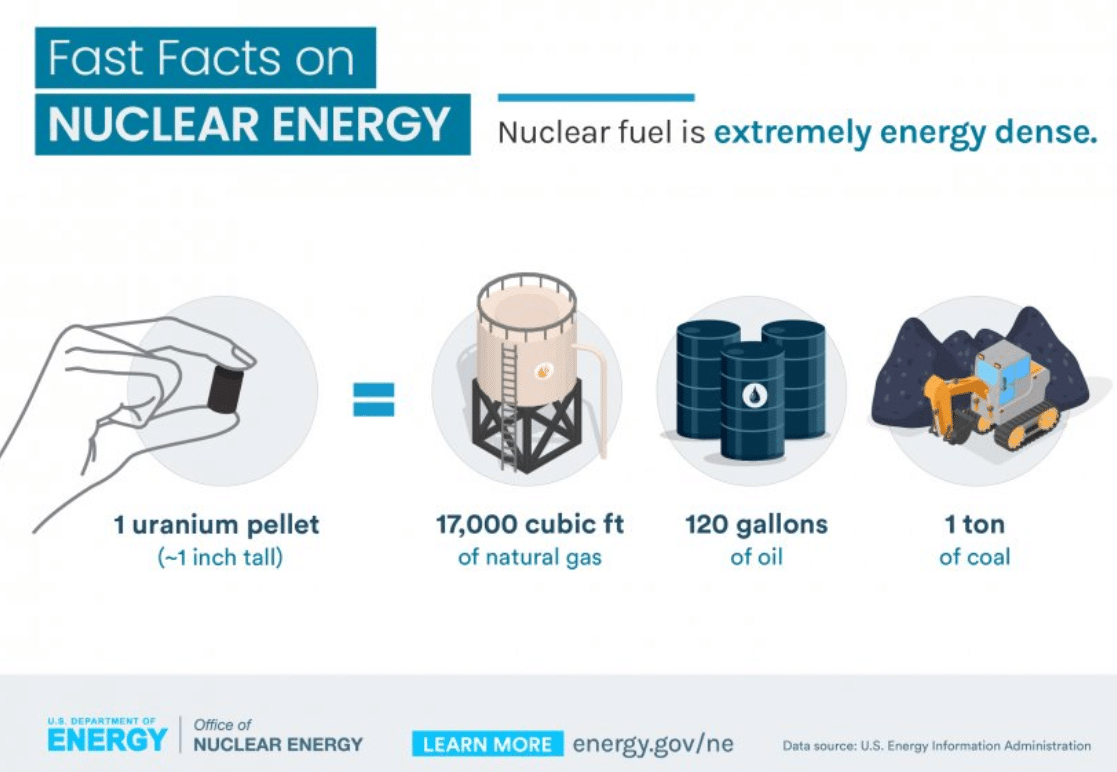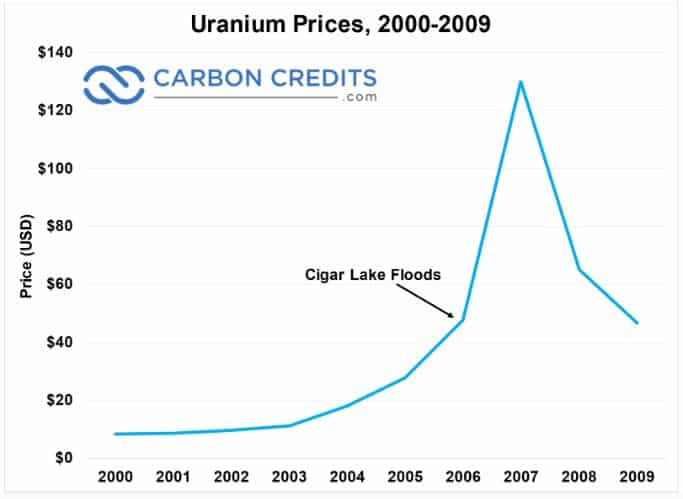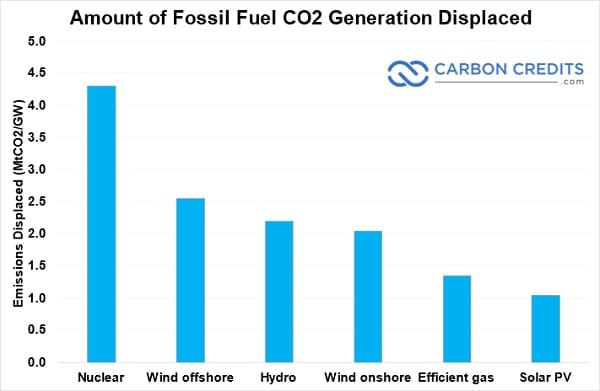In the realm of clean energy, uranium-powered nuclear plants often take a back seat to solar and wind, yet they stand as the second-largest low-carbon electricity source globally. Nuclear energy operates emission-free, mitigating carbon dioxide and curbing harmful air pollutants. It’s not just an alternative; it is pivotal to global clean, sustainable energy transition – the key for net zero emissions.
In this article, we’ll explore the uniqueness and the driving forces behind the resurging interest in nuclear energy. This means delving into the uranium sector, an emerging bullish market and why it’s crucial for a net zero world.
Moving Away From Coal With Nuclear Energy
Transitioning from coal to cleaner energy sources is a pivotal step in addressing climate change.
For centuries, coal was the cornerstone of the industrial revolution, but its combustion accounts for over 40% of global carbon emissions. It’s also responsible for 75% of electricity generation emissions in 2019, as per the International Energy Agency (IEA)’s data.
To align with the Paris Agreement’s objectives of curbing global warming below 1.5°C, phasing out coal is imperative.
The shift toward clean energy involves pivoting from high-emission sources to low-carbon alternatives to mitigate climate impacts. This energy transition aims to eliminate reliance on fossil fuels, amplifying renewable options such as hydro, solar, wind, and nuclear power.
An excellent example of this transition is Ontario, which has been coal-free since 2014, primarily harnessing nuclear and hydro energy to power its grid sustainably.
Both coal and nuclear power plants operate using steam-driven turbines to generate electricity. Despite coal accounting for roughly ⅓ of global electricity generation, nuclear energy stands out for its capability to provide consistent baseload power, effectively supplementing intermittent renewable sources like solar and wind.
World Total Electricity Production by Energy Source

Back in 2003, Ontario pledged to phase out a quarter of its electricity generation by decommissioning nearly 9000 MW of coal capacity. To achieve this, the province refurbished nuclear units and integrated a mix of renewables and natural gas. Doing so allowed the Canadian province to successfully attain over 90% carbon-free electricity.
It’s a testament to the feasibility of transitioning away from coal toward cleaner, more sustainable energy sources like nuclear.
The adaptability of nuclear power plants in adjusting output according to demand and the availability of other energy sources adds resilience and stability to the grid, particularly in supporting variable renewables.
The recent report by the United States’ Department of Energy on nuclear power highlighted the potential to convert over 250 GW of coal capacity in the U.S. into nuclear power, effectively doubling the existing nuclear capacity.
Moreover, the DOE’s analysis revealed various benefits for communities near the coal plants considering such a transition. This includes the creation of 650 jobs, generating $275 million in economic activity, and an 86% reduction in GHG emissions.
Deputy secretary, Andrew Griffith, noted that the expertise and skills learned from operating coal plants could be adapted to nuclear power. He further underlined that this potential extends beyond just integrating into the electricity grid, as some reactor concepts can also offer applications in industrial heat.
The agency also emphasized the multi-dimensional benefits that nuclear power could offer for the energy transition.
Nuclear as Clean and Sustainable Energy Source
When the term “clean energy” is mentioned, most individuals tend to immediately think of solar panels or wind turbines. However, nuclear energy, often overlooked in these discussions, stands as the second-largest source of low-carbon electricity globally, trailing only hydropower.
To understand the cleanliness and sustainability of nuclear energy, consider these three key points:
- Zero Emissions and Air Quality Protection:
Nuclear energy is a zero-emission clean energy source. It operates via fission, splitting uranium atoms to generate energy. The resulting heat drives turbines for electricity production without emitting harmful byproducts present in fossil fuels.
In 2020, the United States avoided over 471 million metric tons of carbon dioxide emissions through nuclear energy, surpassing the collective impact of all other clean energy sources combined.
- Small Land Footprint:
Despite generating substantial carbon-free power, nuclear energy requires minimal land compared to other clean sources. A standard 1,000-megawatt nuclear facility in the U.S. operates on slightly over 1 square mile.
In comparison, wind farms require 360x more land area, while solar plants demand 75x more space to produce equivalent electricity. In other words, millions of solar panels or hundreds of wind turbines are needed to match the power output of a typical nuclear reactor.
- Extremely High Energy Density with Minimal Waste:
Nuclear fuel boasts an incredibly high energy density, nearly 1 million times greater than traditional energy sources. Consequently, the volume of used nuclear fuel isn’t as extensive as commonly believed.
Putting that in perspective: all the used nuclear fuel produced by the U.S. nuclear energy sector over 6 decades could fit within the dimensions of a football field at a depth of less than 10 yards.
This waste can potentially be reprocessed and recycled, although this isn’t currently practiced in the U.S. However, emerging advanced reactor designs aim to operate on used fuel, offering promising solutions.
Consider the following facts. They underscore the significance of nuclear energy in the realm of clean and sustainable power generation.

Uranium Bull Market is Emerging
Delving into the current market scenario, it helps to consider the historical context of the past decades.
Going back to the ‘60s and ‘70s, these were the pivotal periods when nuclear power stations were extensively built. These years marked the initial rise in demand coinciding with the emergency of nuclear technology.
Unfortunately, a series of accidents, Three Mile Island and Chernobyl, led to nuclear downturn that put many projects on hold. This downturn persisted for about two decades.
Fast forward to the early 2000s, the climate change challenges start to kick in, particularly the increasing greenhouse gas emissions. This moment was dubbed the Renaissance of nuclear energy when new projects were revealed. Consequently, this resulted in a spike in 2007 as shown in the chart.
Then there has been a gradual but consistent uptick in uranium prices since 2019. Notably, this trend showed investors’ interest resurging due to the perceived potential in uranium investments. And a few days ago, uranium spot prices hit a 15-year high at $85 per pound.

How Does Uranium Help Achieve Net Zero Emission?
Uranium plays a significant role in the quest for achieving “net zero emissions“. It boasts a feature lacking in some renewable energy sources – capacity to provide reliable baseload energy production.
While solar, renewables, and hydroelectric power receive continued investment due to their eco-friendliness, they face challenges in delivering consistent energy output. For instance, solar energy is inactive at night, and wind turbines remain idle when there’s no wind. Recent occurrences, such as lower wind speeds in the United Kingdom resulting in decreased turbine energy production, have forced a shift to natural gas.
Although natural gas is a cleaner energy source compared to coal or oil, its carbon footprint remains notably higher. Surprisingly, a substantial portion of the world still heavily relies on coal for electricity generation.
In the United States, for instance, 19% of energy production persists from coal. Even in China, despite significant strides in reducing reliance on coal from 70% to 57% over a decade, there’s a fervent drive to further diminish this figure. This fuels China’s leadership in expanding nuclear capabilities as an alternative to coal.
Regardless if it’s coal or natural gas, it doesn’t matter. Nuclear is nearly 100% more effective than any other energy technology at reducing carbon emissions.
These developments resonate strongly with investors, particularly in the context of Environmental, Social, and Governance (ESG) considerations. Many investors view nuclear energy as a low-carbon means of energy production, aligning with ESG principles. The rising importance of ESG considerations has sparked newfound interest in evaluating nuclear energy’s place within this framework.
Overall, the reliability and low-carbon nature of nuclear energy underscore its significance in pursuing cleaner and dependable energy solutions. There’s simply no reaching net zero without nuclear, and so uranium, too.
Disclosure: Owners, members, directors and employees of carboncredits.com have/may have stock or option position in any of the companies mentioned: GLDG
Carboncredits.com receives compensation for this publication and has a business relationship with any company whose stock(s) is/are mentioned in this article
Additional disclosure: This communication serves the sole purpose of adding value to the research process and is for information only. Please do your own due diligence. Every investment in securities mentioned in publications of carboncredits.com involve risks which could lead to a total loss of the invested capital.



